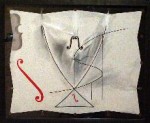The strange paintings of a brilliant madman

Florida has become associated with sunshine, beaches and theme parks, all of which have become familiar to residents. But did you know that Floridians can also attest to having one of the two largest collections of work by Salvador Dalà in the world?
The Salvador Dalà Museum in St. Petersburg houses a magnificent collection of works by Dalà and is currently exhibiting three works loaned from the Dalà Foundation in Spain.
The three loaned works are among the first paintings viewers encounter after passing through security and entering the exhibition space. The first is “Group of Women Imitating the Gestures of a Schooner.” Painted in 1940, it features three elongated and slender female figures with sails that appear to stem straight from their bodies. The figures act as a schooner, a type of sailing vessel, seemingly succumbing to the wind as the sails, tied to their forearms, thighs and nipples, catch the breeze and gradually pull them forward.
Though the figures are not entirely defined, their bodies seem muscular and taut as the sails inflate. Dalà chose a limited palette for this painting, implementing only browns, blues, blacks and whites. Although all of the loaned pieces are oil paint on canvas, it is most apparent in “Group of Women,” as Dalà applied the paint heavily in some areas. This allows viewers, if they look closely enough, to see the texture of the paint as it is raised off the canvas.
Female figures with sails attached to their bodies are a recurring theme in DalÃ’s work, as are the thin, dark crutches supporting various limbs of these figures. In another piece by Dalà called “The Ship,” the body of a woman is shown taking the place of the body of a ship with the sails attached accordingly as she moves forward.
Next, the “Ascension of St. Cecilia,” finished in 1955, depicts a female figure amid a shower of fragmented rhinoceros horns. Again, Dalà used very few colors for the majority of this canvas, with the rhinoceros horns painted a dark gray on a lighter background color. Observed from afar, the fragmented horns seem to dominate the composition, making the female figure almost indiscernible. However, upon approaching the work, the brightly robed figure of St. Cecilia seems to emerge almost magically.
Upon inspection, the image of St. Cecilia appears transparent as she raises her face to the sky and seems to disintegrate into the various rhinoceros horn particles. It is understood that Dalà was influenced by Italian Renaissance painter Raphael in composing his own image of Cecilia. Viewers can appreciate DalÒs astounding control over the medium. Many of DalÒs works offer crisp, clean images that hardly look as though created with paint.
Finally, “The Swallow’s Tail – Series on Catastrophes” (1983) is considered one of DalÃ’s last works. “The Swallow’s Tail” is a true display of DalÃ’s technical skill and cleverness as a painter. The painting presents what looks like a white piece of paper, or perhaps a stiff canvas that’s crumpled and torn in some areas and looks as though it is being stretched out to various points around the edge of the canvas. On the stretched material Dalà has painted various solid black lines and a grayish-blue silhouette of half a cello in the upper left corner, in addition to the f-holes of a cello painted in solid black and red.
The plaque to the right of the piece reveals it was based on the theories of French mathematician René Thom. This work is very unlike the majority of the pieces in the exhibition, as it is more minimal and abstract than the work Dalà is known for. It is fascinating to compare “Swallow’s Tail,” one of DalÃ’s last paintings, to another painting in the St. Petersburg collection, “Landscape,” which is thought to be DalÃ’s first painting. This marks the first time these two works – “Landscape” and “Swallow’s Tail” – have ever been exhibited together, serving as a testimony to the fascinating progression of DalÃ’s skills and creativity as one of art’s most influential painters.
The pieces are on loan from the Dalà Foundation in Spain until March 2008. The Dalà Museum is located at 1000 3rd St. S. in St. Petersburg. The museum is open Monday – Wednesday 9:30 a.m. – 5:30 p.m., Thursday 9:30 a.m. – 8 p.m., Friday 9:30 a.m. – 6:30 p.m., Saturday 9:30 a.m. – 5:30 p.m. and Saturday 12 p.m. – 5:30 p.m.





